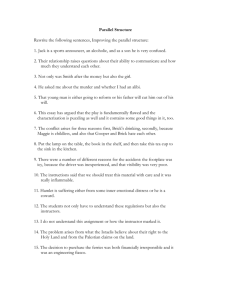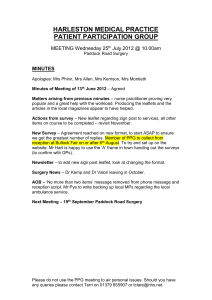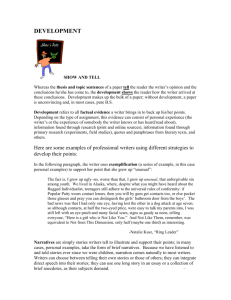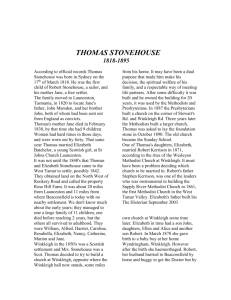A modified footplate for the Kerrison rongeur Please share
advertisement
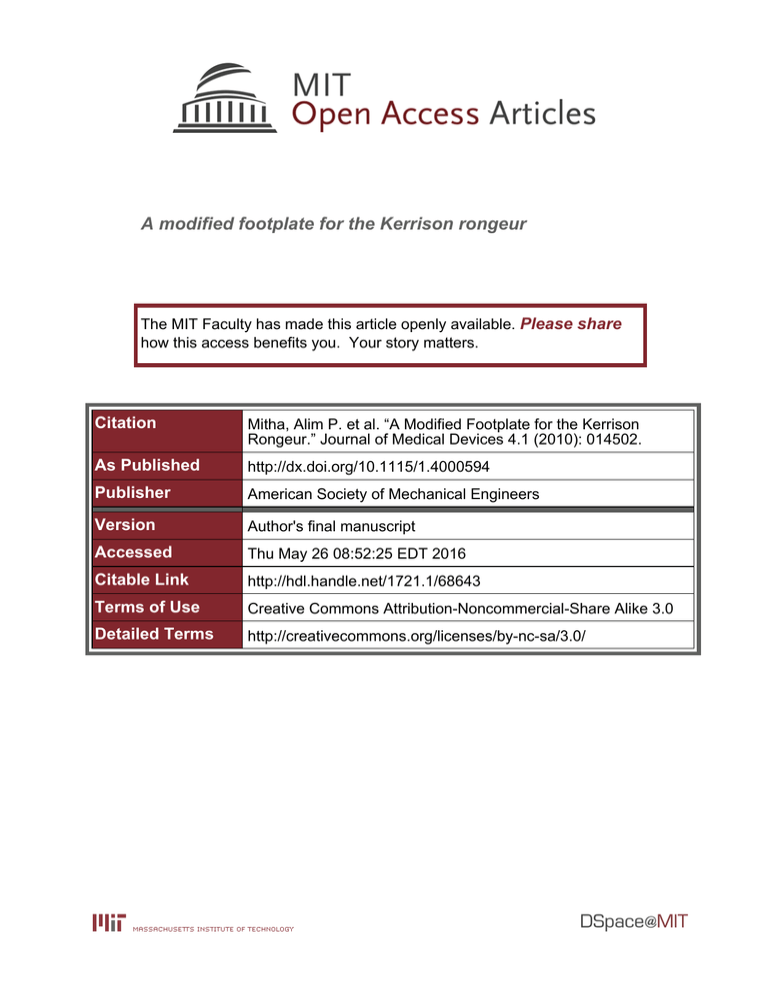
A modified footplate for the Kerrison rongeur The MIT Faculty has made this article openly available. Please share how this access benefits you. Your story matters. Citation Mitha, Alim P. et al. “A Modified Footplate for the Kerrison Rongeur.” Journal of Medical Devices 4.1 (2010): 014502. As Published http://dx.doi.org/10.1115/1.4000594 Publisher American Society of Mechanical Engineers Version Author's final manuscript Accessed Thu May 26 08:52:25 EDT 2016 Citable Link http://hdl.handle.net/1721.1/68643 Terms of Use Creative Commons Attribution-Noncommercial-Share Alike 3.0 Detailed Terms http://creativecommons.org/licenses/by-nc-sa/3.0/ Modified Footplate for the Kerrison Rongeur A Modified Footplate for the Kerrison Rongeur Alim P. Mitha, M.D., S.M.1,2 Mohamed S. Ahmad, S.M.1 Sarah J. Cohen, M.S.1 Janet S. Lieberman, B.S. 1 Martin R. Udengaard, M.S.1 Alexander H. Slocum, Ph.D1 Jean-Valery C.E. Coumans, M.D.2 Department of Mechanical Engineering, Massachusetts Institute of Technology, Cambridge, MA 2 Department of Neurosurgery, Massachusetts General Hospital, Boston, MA 1 Corresponding Author Jean-Valery Coumans, M.D. Department of Neurosurgery Massachusetts General Hospital 55 Fruit Street, WAC-0-21 Boston, MA 02114-3117 Tel: (617) 726-3776 Fax: (617) 724-0339 e-mail: jcoumans@partners.org Alim P. Mitha Page 1 12/21/2007 Modified Footplate for the Kerrison Rongeur ABSTRACT Background Use of the Kerrison rongeur for bone removal in spinal surgery is associated with dural tears and cerebrospinal fluid leaks. We report a modification of the Kerrison rongeur footplate designed to reduce the risk of dural tears. Method of Approach A novel footplate was designed by incorporating the following parameters: 1) tapering the footplate to deflect soft tissue downward during positioning of the rongeur underneath the bone and 2) making the footplate longer and wider than the cutting element to prevent soft tissue from seeping into the cutting surface. Stereolithography models of the modified footplate were made and tested in a cadaver. The modified footplate was then incorporated into an existing Kerrison rongeur as a working prototype, and tested in 20 laminectomy cases to clinically validate its design. Results The modified footplate prevented soft tissue from entering the cutting surface of the Kerrison rongeur in the manner intended by its design. No dural tears or CSF leaks were encountered in any instance. Potential soft tissue compression caused by an increase in footplate dimensions was not a significant issue in the rongeur size tested. This modification, however, might not be practical in rongeurs larger than 3mm. Conclusions The risk of dural tears and cerebrospinal fluid leaks in spinal surgery may be reduced by this footplate modification of the Kerrison rongeur. Soft tissue compression may limit the incorporation of this modification to rongeurs 3mm or smaller. Keywords: Intraoperative complication, laminectomy, spinal stenosis, spine surgery,surgical instruments Alim P. Mitha Page 2 12/21/2007 Modified Footplate for the Kerrison Rongeur BACKGROUND Unintended durotomies are common and have been reported to occur in 4-16% [Epstein,13,14] of lumbar spine operations. Since lumbar laminectomies and discectomies are among the most common procedures performed in hospitals (excluding those related to pregnancy and childbirth) [6], incidental durotomy is a problem of significant epidemiological importance. Sequelae include headache, tinnitus, vertigo, nerve palsies, pseudomeningocele, durocutaneous fistulas, intracranial hemorrhage, meningitis, arachnoiditis, and epidural abscess [10]. Although some authors have advocated early mobilization [4,8], incidental durotomy frequently results in extended periods of bed rest or CSF diversion [5,15] and may require reoperation for repair [4,8]. While some authors have found no significant long-term effects at 2 years [1,7], others have found it to adversely affect outcome 10 years postoperatively [11]. In addition to the clinical implications, incidental durotomy is the second most common cause of litigation in spine surgery [3], itself the dominant source of malpractice claims in Neurosurgery [2]. In lumbar surgery, dural tears are most often associated with use of the Kerrison rongeur [13]. This can occur while tearing ligament or scar tissue adherent to dura, or if a fold of dura inadvertently is caught into the cutting surface. Although many different proprietary versions of the Kerrison rongeur exist, few modifications have been previously reported, and none specifically address its safety [9,12]. Here, we report a useful modification of the rongeur footplate intended to prevent dural tears. Alim P. Mitha Page 3 12/21/2007 Modified Footplate for the Kerrison Rongeur METHOD OF APPROACH Technical Description It is believed that the current design of the Kerrison rongeur does little to prevent the occurrence of dural tears during use. A number of modification strategies were studied including an active retractable metal barrier, a jet of pressurized air, altering the closure force and altering the size and shape of the footplate and shaft. The simplest and least cumbersome modification involved altering the footplate so that it deliberately keeps soft tissue away from the cutting surface. Two specific design parameters were employed to accomplish this goal: 1) the footplate was tapered to deflect soft tissue downward during positioning of the rongeur underneath the bone and 2) the footplate was made both longer and wider than the cutting element to prevent soft tissue from seeping between opposing surfaces during instrument occlusion. The tapered end of the rongeur reduces the amount of material at the tip of the footplate, resulting in less underlying soft tissue compression. Meanwhile, the strength of the cantilever design is maintained since the force on the footplate is concentrated at its root, and perhaps improved due to the introduction of a flange [Fig. 1]. Initially, plastic stereolithography (SLA) models of the footplate were designed using computer-aided design software (SolidWorks Corporation, Concord, MA) and produced as snap-on additions to an existing 3 mm Kerrison rongeur. Two of these models with different sizes of overhang (0.5 and 1 mm) were made then tested in a cadaveric model [Fig. 2]. Alim P. Mitha Page 4 12/21/2007 Modified Footplate for the Kerrison Rongeur RESULTS Laboratory Testing While some improvement over the current design was noted with the 0.5 mm addition, dural tears were still possible. The 1 mm addition, however, effectively prevented soft tissue from entering the cutting surface, and resulted in little additional interference while manipulating the footplate of the rongeur underneath the bone. Clinical Experience A prototype with 1 mm of additional length and width of footplate was produced by machining and microwelding an addition of surgical grade stainless steel onto an existing 3 mm Kerrison rongeur [Fig. 3]. We documented the effectiveness of this footplate in clinical applications by testing it on 20 patients undergoing surgical treatment of spinal stenosis and we continue to use it routinely in spine cases. Despite its tapered end, the footplate retained its strength. We found that the modified footplate prevents soft tissue from entering the cutting surface of the Kerrison rongeur in the manner intended by its design, and no dural tears or CSF leaks have been encountered to date. Thus the modified Kerrison appears effective at preventing incidental durotomy. DISCUSSION Use of the Kerrison rongeur may be associated with tearing of the dura by nature of its design. The lack of direct visualization, along with the absence of inherent active or passive mechanisms to exclude soft tissue from the instrument’s cutting surface, places Alim P. Mitha Page 5 12/21/2007 Modified Footplate for the Kerrison Rongeur adjacent structures at risk. In this paper, we describe a modification intended to improve the safety of the Kerrison rongeur and to prevent potential morbidities associated with dural tears. Since incidental durotomies are frequent [13,14] and are associated with added morbidity [11], trying to reduce the occurrence of this common complication is important. Specifically, our design involved two passive modules: 1) tapering the undersurface in order to deflect tissue downward during positioning of the footplate underneath the bone and 2) increasing the dimensions of the footplate at its forward and lateral aspects to keep soft tissue away from the opposing surfaces of the instrument [Fig. 3]. The modification was first designed as a snap-on addition to an existing rongeur and various sizes of the footplate were tested on cadaveric models. A fully functional prototype of the footplate was then produced by a machining process, followed by microwelding of the addition onto an existing Kerrison rongeur. This prototype proved to be effective in 20 laminectomy cases and did not cause any adverse effects. There are two disadvantages to this modification. Since the footplate size has been increased, one effectively loses cutting width with each bite. The prototype tested was built into an existing 3 mm rongeur, and the size of the modified footplate added 1 mm of length at the forward aspect and 1 mm of width on each side. It is likely that similar modifications on 4 and 5 mm rongeurs will be impractical due to the excessive width of the resulting footplate and difficulty inserting and positioning the instrument. Additionally, since the cutting surface does not come right up to the edge of the Alim P. Mitha Page 6 12/21/2007 Modified Footplate for the Kerrison Rongeur instrument, there are situations in which the instrument is ill-suited, such as removing small bone spicules from the cut edge of a laminectomy for example. The modified instrument however is ideal for central canal decompression, especially when the dura is patulous or when working in a lordotic region of the spine, such as the L5-S1 junction, where the dura can abut the leading edge of the instrument. Our modification is not intended to eliminate the usual epidural dissection, especially for reoperations. Cerebrospinal fluid leaks are still possible if one tears tissue adherent to dura, as may occur with dull instruments. The usual preparatory practice of detaching any dural adhesions from the overlying bone or ligament is still required, although the leading edge of the instrument itself can function as a dissecting tool. In this regard, this footplate design appears to confer an advantage in terms of preventing dural tears caused by the simultaneous inclusion of bone and soft tissue inside the cutting surface of the instrument. CONCLUSIONS We modified the footplate of a Kerrison rongeur in an effort to reduce the incidence of CSF leaks in spinal surgery. The instrument bears a wider, more tapered footplate that effectively counteracts the tendency of soft tissue to enter the cutting surfaces. The modified Kerrison rongeur has been used effectively, and has not been associated with unintended durotomies in 20 patients. Alim P. Mitha Page 7 12/21/2007 Modified Footplate for the Kerrison Rongeur REFERENCES 1. Epstein, N.E., 2007, “The Frequency and Etiology of Intraoperative Dural Tears in 110 Predominantly Geriatric Patients undergoing Multilevel Laminectomy with Noninstrumented Fusions,” J. Spinal Disord. Tech, 20, pp. 380-386. 2. Sin, A.H., Caldito, G., Smith, D., Rashidi, M., Willis, B., Nanda, A., 2006, “Predictive Factors for Dural Tear and Cerebrospinal Fluid Leakage in Patients undergoing Lumbar Surgery,” J. Neurosurg. Spine, 5, pp. 224-227. 3. Tafazal, S.I., Sell, P.J., 2005, “Incidental Durotomy in Lumbar Spine Surgery: Incidence and Management,” Eur. Spine J., 14, pp. 287-290. 4. Procedures in U.S. Hospitals, 2003: HCUP Fact Book, 2003, “Top 10 Procedures Performed in U.S. Hospitals (Excluding Pregnancy- and Childbirth-Related Procedures),” http://www.ahrq.gov/data/hcup/factbk7/fbk7tab4.htm, accessed December 7, 2007. 5. Narotam, P.K., Jose, S., Nathoo, N., Taylon, C., Vora, Y., 2004, “Collagen Matrix (DuraGen) in Dural Repair: Analysis of a New Modified Technique,” Spine, 29, pp. 2861-2867. 6. Hodges, S.D., Humphreys, S.C., Eck, J.C., Covington, L.A., 1999, “Management of Incidental Durotomy without Mandatory Bed Rest. A Retrospective Review of 20 Cases,” Spine, 24, pp.2062-2064. 7. Khan, M.H., Rihn, J., Steele, G., Donaldson, W.F., Kang, J.D., Lee, J.Y., 2006, “Postoperative Management Protocol for Incidental Dural Tears During Degenerative Lumbar Spine Surgery: A Review of 3,183 Consecutive Degenerative Lumbar Cases,” Spine, 31, pp. 2609-2613. 8. Hughes, S.A., Ozgur, B.M., German, M., Taylor, W.R., 2006, “Prolonged Jackson-Pratt Drainage in the Management of Lumbar Cerebrospinal Fluid Leaks,” Surg. Neurol., 65, pp. 410-414. 9. Wang, J.C., Bohlman, H.H., Riew, K.D., 1998, “Dural Tears Secondary to Operations on the Lumbar Spine. Management and Results after a Two-YearMinimum Follow-up of Eighty-Eight Patients,” J. Bone Joint Surg. Am., 80, pp. 1728-1732. 10. Cammisa, F.P., Girardi, F.P., Sangani, P.K., Parvataneni, H.K., Cadag, S., Sandhu, H.S., 2000, “Incidental Durotomy in Spine Surgery,” Spine, 25, pp. 2663-2667. Alim P. Mitha Page 8 12/21/2007 Modified Footplate for the Kerrison Rongeur 11. Jones, A.A., Stambough, J.L., Balderston, R.A., Rothman, R.H., Booth, R.E., 1989, “Long-term Results of Lumbar Spine Surgery Complicated by Unintended Incidental Durotomy,” Spine, 14, pp. 443-446. 12. Saxler, G., Kramer, J., Barden, B., Kurt, A., Pfortner, J., Bernsmann, K., 2005, “The Long-Term Clinical Sequelae of Incidental Durotomy in Lumbar Disc Surgery,” Spine, 30, pp. 2298-2302. 13. Goodkin, R., Laska, L.L., 1995, “Unintended "Incidental" Durotomy during Surgery of the Lumbar Spine: Medicolegal Implications,” Surg. Neurol., 43, pp. 4-12. 14. Fager, C.A., 2006, “Malpractice Issues in Neurological Surgery,” Surg. Neurol. 65, pp. 416-421. 15. Lemke, B.N., Wexler, S.A., Woog, J.J., 1986, “A Modification of the Kerrison Rongeur,” Am. J. Ophthalmol., 101, pp. 384-385. 16. Sim, E., 2002, “A Useful Modification of the Kerrison Rongeur,” Spine, 27, pp E9-10. Alim P. Mitha Page 9 12/21/2007 Modified Footplate for the Kerrison Rongeur FIGURE LEGENDS 1. A novel footplate design was created for the Kerrison rongeur that features a tapered bottom as well as a top surface that is wider and longer than the cutting shaft. This geometry was intended to deflect surrounding soft tissue from the cutting area. A, Angled view, B, side view. 2. Stereolithography (SLA) was used to create a model of the modified footplate as a snap-on addition to an existing Kerrison rongeur. Here, the model (1 mm of overhang) is being tested in a cadaver spine to assess for potential risks and benefits prior to intraoperative use. The footplate design allows for clearance of dura away from the cutting surface. 3. A prototype of the modified Kerrison rongeur was made by microwelding an addition of surgical grade stainless steel onto an existing Kerrison rongeur. A, Side view showing tapered footplate. B, Front view showing flange. C, Top view showing the wider footplate dimensions relative to the shaft. D, Top view with instrument in occlusion. Alim P. Mitha Page 10 12/21/2007 Modified Footplate for the Kerrison Rongeur FIGURE 1 Alim P. Mitha Page 11 12/21/2007 Modified Footplate for the Kerrison Rongeur FIGURE 2 Lamina Dural Sac Alim P. Mitha Page 12 12/21/2007 Modified Footplate for the Kerrison Rongeur FIGURE 3A FIGURE 3B Alim P. Mitha Page 13 12/21/2007 Modified Footplate for the Kerrison Rongeur FIGURE 3C Alim P. Mitha Page 14 12/21/2007 Modified Footplate for the Kerrison Rongeur FIGURE 3D Alim P. Mitha Page 15 12/21/2007 Modified Footplate for the Kerrison Rongeur Alim P. Mitha Page 16 12/21/2007
